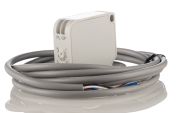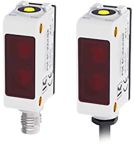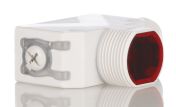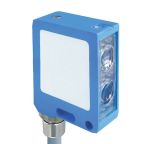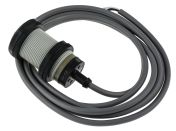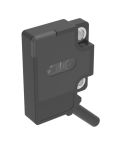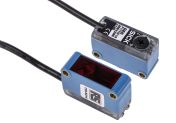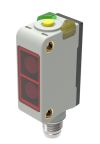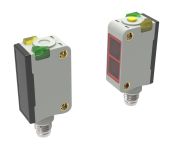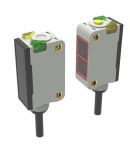Photoelectric Sensors
Photoelectric sensors, also known as photocells, are electronic devices that leverage light to detect objects, changes in surface conditions, or other physical attributes. They function on the principle of emitting a field or beam of electromagnetic radiation from an emitter and receiving the reflected or interrupted light at a receiver. By analysing the changes in the received light signal, these sensors can accurately determine the presence or absence of an object, measure distances, or monitor various optical properties.
This core functionality makes photoelectric sensors invaluable across various industries, functioning as reliable photoelectric switch sensors in automation, safety systems, and countless other applications.
Types of Photoelectric Sensors
There are various types of photoelectric sensors, with the main ones comprising of through-beam, retro-reflective and diffuse, which vary slightly in the way they function.
The basic function of each is to detect the presence or absence of objects or measure the distance to the object.
Through-beam Sensors
Through Beam Sensors (aka thru-beam) rely on two separate housings, one for the transmitter and one for the receiver, with the transmitter providing a continuous beam of light to the receiver. Each time an object passes through the beam this interrupts the signal between the transmitter and receiver, which in turn causes the receiver to send an electrical signal to the output.
Benefits:
- Exceptional Sensing Range: Through-beam photoelectric sensors boast impressive sensing distances, ranging from a few centimetres to several tens of metres, making them suitable for a wide array of applications.
- Consistent Performance: These sensors offer stable operation even when the object's path varies, ensuring reliable detection in dynamic environments.
- Versatility: They can detect objects of different colours, gloss levels, and orientations, providing flexibility in various sensing scenarios.
- High Accuracy: The direct light path between the transmitter and receiver minimises false triggers, resulting in precise and dependable object detection.
Retro-reflective Sensors
Retro-reflective sensors integrate the transmitter and receiver into a single unit, simplifying installation. They utilise a reflector positioned opposite the sensor to create a light path. When an object interrupts this path, the receiver detects the change in reflected light and generates an output signal.
Benefits:
- Simplified Setup: With both transmitter and receiver in one housing, wiring and alignment are straightforward, saving installation time and effort.
- Versatile Sensing Range: These sensors offer a practical sensing range of several centimetres to several metres, accommodating various applications.
- Reliable Detection: The operation remains largely unaffected by the colour or angle of the object, ensuring consistent detection in diverse scenarios.
- Transparent Object Detection: The light beam passes through the object twice, making these sensors particularly effective for sensing transparent materials.
- Polarisation Filters: Specialised filters enable the detection of highly reflective objects like aluminium by distinguishing between the light reflected from the object and the reflector.
Diffuse Sensors
Diffuse photoelectric sensors (proximity sensor) are easier to install as only one device must be mounted. Diffuse sensors use the reflection from the target object within a predetermined sensing range.
The transmitter sends out a continuous beam of light, once this hits the target it is diffused in all directions, a part of this light is reflected and recognised by the receiver, the receiver then sends an electrical signal to the output.
Benefits:
- Effortless Installation & Adjustment: With a single unit design, mounting and alignment are incredibly easy, requiring minimal effort and time.
- Adaptable Sensing Range: Diffuse sensors offer a sensing range spanning from centimetres to metres, accommodating diverse applications.
- Compact & Versatile: Their small footprint makes them suitable for space-constrained environments, and they can be used to detect a variety of objects.
- Background Suppression Models: These specialised diffuse sensors allow precise control of the sensing range, even with challenging backgrounds, ensuring reliable detection.
Laser-reflective Sensors
Laser-reflective sensors operate on the same principle as retro-reflective sensors but utilise a highly focused laser beam for detection. This allows for exceptional precision and extended sensing distances, making them suitable for demanding applications.
Benefits:
- Pinpoint Accuracy: The narrow and focused laser beam enables precise detection of even the smallest objects or features.
- Extended Range: Laser-reflective sensors offer impressive sensing distances, reaching up to tens of metres, making them ideal for long-range applications.
- Immunity to Ambient Light: The laser's specific wavelength minimises interference from external light sources, ensuring reliable detection in various lighting conditions.
- High Repeatability: The laser's consistent beam properties contribute to highly repeatable and accurate measurements.
Applications of Photoelectric Sensors
Photoelectric Sensors can be used in various settings, some of which include:
- Food Industry
- Pharmaceutical Industry
- Packaging Plants
- Automotive Industry
- Doors & Gates
- Material Handling & Transportation
- Machine Tools & Industrial Automation
- Safety & Security
Your Trusted Photoelectric Sensor Supplier in Singapore
Discover a comprehensive range of photoelectric sensors at RS Singapore, your one-stop shop for reliable sensors. We partner with industry-leading brands like Omron, Banner Engineering, and Sick to offer a vast selection of high-quality photoelectric sensors, including through-beam, retro-reflective, and diffuse-reflective sensors, catering to diverse automation and detection needs.
At RS, we prioritise quality and customer satisfaction. Our extensive inventory ensures you have access to the sensors you need, when you need them, backed by expert technical support and customer service.
Simplify your purchasing process with our user-friendly online catalogue, making it easy to find and order the ideal photoelectric sensors for your application. We also offer fast next-working-day delivery throughout Singapore, enabling you to keep your projects on track without delays. For detailed information about our delivery options and policies, please visit our Delivery Information page.
Choose RS Singapore for a seamless and efficient photoelectric sensor buying experience that meets the demands of your sensing applications. Browse the broad range of photoelectric sensors RS has to offer and order today for next day delivery.
Popular Searches
Related links
- Telemecanique Sensors Sensor Reflector for Use with XUJ Photo Electric Sensor
- Telemecanique Sensors Sensor Reflector for Use with Reflex Photo Electric Sensor
- photo-electric sensor - XUY - diffuse -
- Baumer Through Beam Sensor Photoelectric Sensor 5 m Detection Range
- ifm electronic Through Beam Sensor Photoelectric Sensor 0.05 mm Detection Range IO-LINK
- Pepperl + Fuchs Through Beam Distance Sensor 550 mm Detection Range
- Thru-beam sensor
- RS PRO Through Beam Photoelectric Sensor 0 → 30000mm Detection Range IO-LINK

